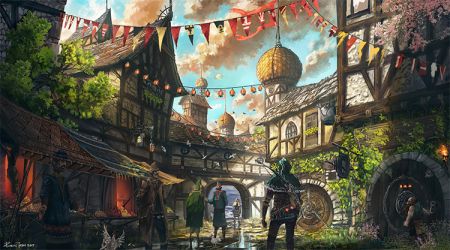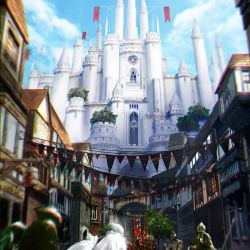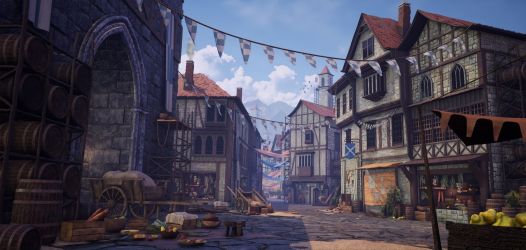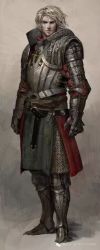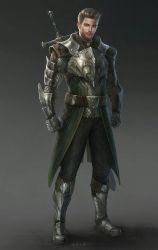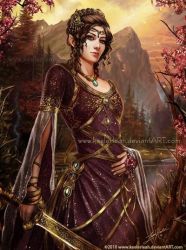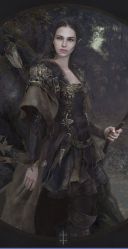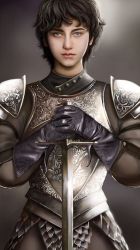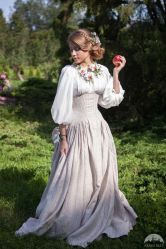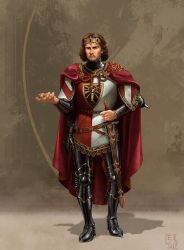Changes: Sim Layout, City-States, RPCSS Factions, and Storyline. Read More
Difference between revisions of "Telrae’dor"
From The Citadel
(Created page with "350px|right''Fiction Parallels.category:Character *Where is the city located geographically. *What is the architecture like *How do they gather...") |
|||
| Line 9: | Line 9: | ||
*Which city-states do they like and dislike | *Which city-states do they like and dislike | ||
*What is their political mindset | *What is their political mindset | ||
| + | |||
| + | Gentry personality is complex and diverse. It is important to remember that their ancestral bloodline of the Tuatha De Dannan provides them with a deeply alien mindset which has been mostly, but not entirely, muted by the good nature of the original humans. We see the alienisms of the Gentry most especially during times of stress, or in the Dubh Gentry. Outwardly, most Gentry are upbeat, outgoing, and curious, sometimes too curious. When you meet introverted Gentry, they also tend towards being shy and sweet. | ||
| + | Dubh Personality | ||
| + | Very charming, ambitious, dominant, self-centered and narcissistic. It is important to note that these traits are considered less than desirable in a potential mate, so characters will do their best to hide them. The Dubh gentry bloodline has been directly connected with some of the most successful villains in Telrae'dor history. | ||
| + | Ban Personality | ||
| + | Frivolous, pleasant, vain, effervescent, flighty, fiercely loyal, self-absorbed and protective. The Ban Gentry are the best combination of the light Sidhe and humans. However, this masks a tendency towards narcissism at worst and self-absorption at best, with an underlying fissure of cruelty that can be activated by doing a Gentry wrong. | ||
| + | The ancient rules of never saying thank you to a Sidhe, and that they never lie do not hold directly to the Sidhe’s hybrid offspring. However, Smallfolk will tell you to never be in debt with any sort to a Gentry, and always expect them to hold to the letter of the law, not the spirit. Most of the negative Gentry traits are strongly associated with the Dubh Gentry, so the average Ban Gentry will do their very best to never show their dark side, but you would be foolish to assume it does not exist. A Gentry would wonder why anyone would be concerned about the idea, “The end justifies the means”. | ||
| + | |||
| + | The trick to playing a Gentry is to know and understand the Word of Athlendyr well enough that you can understand how it may be perverted in the mind of a Gentry. Some have asked of Athlendyr how he tolerates the Gentry twisting his good intentions, and he has been known to say, “Would you prefer that my troubled children had no guide at all?” | ||
;Appearance | ;Appearance | ||
*What is their physical appearance | *What is their physical appearance | ||
*How do they dress | *How do they dress | ||
| + | Light Gentry stand between 5 and 7 feet in height. Willowy of build, with fine noble features that include incredible dexterity, their skin color ranges from Irish pale to natural beige. They have a range of medium to light hair, and light eyes. Light hair may be very soft pastel shades; please see Pinterest. Gentry may have two different colored eyes; lavender, gold and silver eye color is acceptable. | ||
| + | |||
| + | Physical AppearanceGentryears.jpg | ||
| + | Bán Gentry have light-medium skin tone, light hair color and light eye color. Read more. | ||
| + | Bán Gentry are "human normal" with slightly pointed ears, optional eyes of two different colors, optional pastel hair color. See picture to right for ear reference. | ||
| + | Bán Gentry are of standard and petite Height and a Slender Body Type. | ||
| + | Dark Gentry (or Dubh Gentry)[edit] | ||
| + | |||
| + | Dark Gentry stand between 5 and 7.75 feet in height and are more physically imposing than Bán gentry with limited dexterity. Skin ranges from Irish pale to natural beige. They have a range of dark hair and even black hair with purple, red, green and blue highlights (the color accents in the Dubh Gentry are less obvious than in the Light Gentry). They may have two different colored eyes. Their eyes should be from medium to dark colored, one of those eyes may be red. | ||
| + | |||
| + | Physical Appearance | ||
| + | Dubh Gentry have light-medium skin tone, dark-darkest hair color and medium-dark eye color. Read more. | ||
| + | Dubh Gentry are "human normal" and may have slightly pointed ears, optional eyes of two different colors, optional one red eye, optional unusual hair color in dark shades. See picture to right for ear reference. | ||
| + | Dubh Gentry are of standard and giant Height and a Slender-Athletic Body Type. | ||
| + | |||
| + | Gentry will wear just about anything that happens to be in fashion at the time. Women have been known to bring more than one dress to a feast, just in case. In general, they like long floating delicate fairy and elven like styles with stylized floral accents. Accessories will include such things as pearls, cut gemstones, woven gold, lace, beading, embroidery, brocades, velvets, silk, short-haired fur, etc. Things such as bustles, crinolines, petticoats, panniers, wigs, makeup, and bum rolls have gone in and out of fashion along with every Dyrling "upgrade" on Alfarian, Zephrin and Euresu styles. | ||
| + | Gentryfashion.jpgWhen the fashion goes too far in a particular direction, older women will often refrain from following the fashion, both for themselves and for the young girls who have not yet had their coming-out ball. When this happens, these women will choose fashion they feel looks best on them, and is appropriately modest for a very young woman. When at home, most women prefer elven style robes without corsets (this style is also seen in most of the dresses worn by Cersei Lannister). | ||
| + | Men's styles follow three basic styles; knee length tunics are usually worn with a laced or closed doublet over it (in the manner of most of GoT shows), ankle and floor-length robes, and doublets with tight pants or hose. | ||
| + | |||
| + | Travelrobe.jpgThis simple robe is worn by many women of all three kingdoms when travelling and often at home. There are many examples of this robe on marketplace if you search "hooded robe", there is a free one available at the landing. | ||
| + | |||
;Religion | ;Religion | ||
*What are their gods | *What are their gods | ||
*What is their burial and afterlife | *What is their burial and afterlife | ||
*What are some traditions | *What are some traditions | ||
| + | The Dyrling people worship a triple aspect god known as Athlendyr. His aspects are the Warrior, the Father, and the Shadow. The cleric is divided between the salt of the earth Heargweard Monks and the sophisticated and worldly Maessere Priests. Local monasteries are called Colleges, as in the College of Paths in White Briar. The cleric headquarters is known as the Den of Athlendyr and is found on How Island. | ||
| + | Friartuck.jpgThe religion of Athlendry is based on the concept of “deep magic” also known as the Law. To the Gentry, this deep magic is part of their ancient genetic heritage from the Tuatha De Danann. To the Smallfolk this law is the law of nature and the inherent concept of good and evil. Athlendyr does not claim to have written the law but to have been there when it was. | ||
| + | The Dyrlings are the only people who have a complete creation myth. The other religions have only fragments of creation theories. | ||
| + | |||
| + | During the Fall, when the Formorians and other people of the known world pushed the Tuatha De Danann back to White Briar, the Silver Queen demanded the life of a traitor, according to the Ancient Law. In a tale that may seem familiar to you, the Great Lion offered up himself in exchange for the half-bred Gentry boy. He was sacrificed on the great stone altar of How Island. The blade that was used to kill him, remained deeply embedded in the stone altar, and the Silver Queen sunk beneath the waves in the Lady’s Fountain. | ||
| + | |||
| + | The Lion was never publically seen in Telrae’dor again. A hundred years later, during the wars and disease and famine, the dragon-mounted Alfarian warlord Vortigern attacked and destroyed White Briar. For more than thirty years, the Gentry and Smallfolk toiled under the weight of Alfarian rulership. | ||
| + | |||
| + | A boy of uncertain birth who had been living with the monks at the Den of Athlendyr on How Island turned 14, and in that same summer, pulled the silver blade, Gwyndfwlch, from the stone altar. The priests of Athlendyr, recognizing what this might mean had the boy raised up and trained as a holy knight. | ||
| + | |||
| + | This great king and warrior would become associated with the god Athlendry, and would be worshipped as the Warrior, in compliment to the image of the lion as the Father. Five hundred years later, the legends of Ealdor Lioncourt's reign would birth the Golden Rennaissance in Telrae'dor, a period of history that would last to present day, bringing culture, fashion, and education to a broad spectrum of the Dyrling people. (Similar to the Carolingian Rennaissance) | ||
| + | |||
| + | After the Golden Rennaissance[edit] | ||
| + | |||
| + | Priest.jpgThe religion of Athlendyr became more liturgical and was updated from the original Adûnaic. | ||
| + | Large cathedrals and formalized services would begin to win out over local pagan style worship. | ||
| + | |||
| + | The heargweard, traveling and monastic monks, skilled in combat, agriculture, medicine, astronomy, and mediation, would take a back seat to the more highly educated and ambitious priests. | ||
| + | |||
| + | Mæssere Priests were trained in politics, oration, art, literature, philosophy, and finances, and less so in other skills designed to support small farming villages. | ||
| + | |||
| + | The priests also started and benefitted from the holy law that claimed it is not murder to kill an infidel, thus allowing the Crusaders to atone for killing. The sin of killing could be absolved by a specific amount of prayer and tithing. The Maessere Priests were more than happy to perform this expensive service on behalf of the Gentry. | ||
| + | |||
| + | Luckily, the poor smallfolk who had gotten caught up in the crusades were more commonly serviced by the Heargweard Monks who considered charging for prayer to be appalling. | ||
| + | |||
| + | This dichotomy of styles has been the cause for many a debate amount the Dyrling priests, and while the monks became obligated to perform weekly liturgical services, ancient traditions continued afterward during the regular after service feast. It is not uncommon to find a Dyrling monk sitting under the great oak near to the church, dispensing stories, offering marital advice, blessing babies, and predicting one’s love prospects. | ||
| + | To this day, it is the monks who are most likely to teach the children and care for the sick. The priests instead prefer to pray over the patient, for a cost of course. This change has opened the way for Zuben surgeons to set up practices in the larger towns of Telrae'dor. Gentry now prefer to see a Zuberi doctor rather than one of the monks. | ||
;[[Talk:Telrae’dor|Expanded Lore]] | ;[[Talk:Telrae’dor|Expanded Lore]] | ||
:Further reading and links for the culture obsessed. | :Further reading and links for the culture obsessed. | ||
Revision as of 17:52, 16 December 2020
Fiction Parallels.
- Where is the city located geographically.
- What is the architecture like
- How do they gather food
- Personality
- What is their personality
- How do they organize themselves
- Which city-states do they like and dislike
- What is their political mindset
Gentry personality is complex and diverse. It is important to remember that their ancestral bloodline of the Tuatha De Dannan provides them with a deeply alien mindset which has been mostly, but not entirely, muted by the good nature of the original humans. We see the alienisms of the Gentry most especially during times of stress, or in the Dubh Gentry. Outwardly, most Gentry are upbeat, outgoing, and curious, sometimes too curious. When you meet introverted Gentry, they also tend towards being shy and sweet. Dubh Personality Very charming, ambitious, dominant, self-centered and narcissistic. It is important to note that these traits are considered less than desirable in a potential mate, so characters will do their best to hide them. The Dubh gentry bloodline has been directly connected with some of the most successful villains in Telrae'dor history. Ban Personality Frivolous, pleasant, vain, effervescent, flighty, fiercely loyal, self-absorbed and protective. The Ban Gentry are the best combination of the light Sidhe and humans. However, this masks a tendency towards narcissism at worst and self-absorption at best, with an underlying fissure of cruelty that can be activated by doing a Gentry wrong. The ancient rules of never saying thank you to a Sidhe, and that they never lie do not hold directly to the Sidhe’s hybrid offspring. However, Smallfolk will tell you to never be in debt with any sort to a Gentry, and always expect them to hold to the letter of the law, not the spirit. Most of the negative Gentry traits are strongly associated with the Dubh Gentry, so the average Ban Gentry will do their very best to never show their dark side, but you would be foolish to assume it does not exist. A Gentry would wonder why anyone would be concerned about the idea, “The end justifies the means”.
The trick to playing a Gentry is to know and understand the Word of Athlendyr well enough that you can understand how it may be perverted in the mind of a Gentry. Some have asked of Athlendyr how he tolerates the Gentry twisting his good intentions, and he has been known to say, “Would you prefer that my troubled children had no guide at all?”
- Appearance
- What is their physical appearance
- How do they dress
Light Gentry stand between 5 and 7 feet in height. Willowy of build, with fine noble features that include incredible dexterity, their skin color ranges from Irish pale to natural beige. They have a range of medium to light hair, and light eyes. Light hair may be very soft pastel shades; please see Pinterest. Gentry may have two different colored eyes; lavender, gold and silver eye color is acceptable.
Physical AppearanceGentryears.jpg Bán Gentry have light-medium skin tone, light hair color and light eye color. Read more. Bán Gentry are "human normal" with slightly pointed ears, optional eyes of two different colors, optional pastel hair color. See picture to right for ear reference. Bán Gentry are of standard and petite Height and a Slender Body Type. Dark Gentry (or Dubh Gentry)[edit]
Dark Gentry stand between 5 and 7.75 feet in height and are more physically imposing than Bán gentry with limited dexterity. Skin ranges from Irish pale to natural beige. They have a range of dark hair and even black hair with purple, red, green and blue highlights (the color accents in the Dubh Gentry are less obvious than in the Light Gentry). They may have two different colored eyes. Their eyes should be from medium to dark colored, one of those eyes may be red.
Physical Appearance Dubh Gentry have light-medium skin tone, dark-darkest hair color and medium-dark eye color. Read more. Dubh Gentry are "human normal" and may have slightly pointed ears, optional eyes of two different colors, optional one red eye, optional unusual hair color in dark shades. See picture to right for ear reference. Dubh Gentry are of standard and giant Height and a Slender-Athletic Body Type.
Gentry will wear just about anything that happens to be in fashion at the time. Women have been known to bring more than one dress to a feast, just in case. In general, they like long floating delicate fairy and elven like styles with stylized floral accents. Accessories will include such things as pearls, cut gemstones, woven gold, lace, beading, embroidery, brocades, velvets, silk, short-haired fur, etc. Things such as bustles, crinolines, petticoats, panniers, wigs, makeup, and bum rolls have gone in and out of fashion along with every Dyrling "upgrade" on Alfarian, Zephrin and Euresu styles. Gentryfashion.jpgWhen the fashion goes too far in a particular direction, older women will often refrain from following the fashion, both for themselves and for the young girls who have not yet had their coming-out ball. When this happens, these women will choose fashion they feel looks best on them, and is appropriately modest for a very young woman. When at home, most women prefer elven style robes without corsets (this style is also seen in most of the dresses worn by Cersei Lannister). Men's styles follow three basic styles; knee length tunics are usually worn with a laced or closed doublet over it (in the manner of most of GoT shows), ankle and floor-length robes, and doublets with tight pants or hose.
Travelrobe.jpgThis simple robe is worn by many women of all three kingdoms when travelling and often at home. There are many examples of this robe on marketplace if you search "hooded robe", there is a free one available at the landing.
- Religion
- What are their gods
- What is their burial and afterlife
- What are some traditions
The Dyrling people worship a triple aspect god known as Athlendyr. His aspects are the Warrior, the Father, and the Shadow. The cleric is divided between the salt of the earth Heargweard Monks and the sophisticated and worldly Maessere Priests. Local monasteries are called Colleges, as in the College of Paths in White Briar. The cleric headquarters is known as the Den of Athlendyr and is found on How Island. Friartuck.jpgThe religion of Athlendry is based on the concept of “deep magic” also known as the Law. To the Gentry, this deep magic is part of their ancient genetic heritage from the Tuatha De Danann. To the Smallfolk this law is the law of nature and the inherent concept of good and evil. Athlendyr does not claim to have written the law but to have been there when it was. The Dyrlings are the only people who have a complete creation myth. The other religions have only fragments of creation theories.
During the Fall, when the Formorians and other people of the known world pushed the Tuatha De Danann back to White Briar, the Silver Queen demanded the life of a traitor, according to the Ancient Law. In a tale that may seem familiar to you, the Great Lion offered up himself in exchange for the half-bred Gentry boy. He was sacrificed on the great stone altar of How Island. The blade that was used to kill him, remained deeply embedded in the stone altar, and the Silver Queen sunk beneath the waves in the Lady’s Fountain.
The Lion was never publically seen in Telrae’dor again. A hundred years later, during the wars and disease and famine, the dragon-mounted Alfarian warlord Vortigern attacked and destroyed White Briar. For more than thirty years, the Gentry and Smallfolk toiled under the weight of Alfarian rulership.
A boy of uncertain birth who had been living with the monks at the Den of Athlendyr on How Island turned 14, and in that same summer, pulled the silver blade, Gwyndfwlch, from the stone altar. The priests of Athlendyr, recognizing what this might mean had the boy raised up and trained as a holy knight.
This great king and warrior would become associated with the god Athlendry, and would be worshipped as the Warrior, in compliment to the image of the lion as the Father. Five hundred years later, the legends of Ealdor Lioncourt's reign would birth the Golden Rennaissance in Telrae'dor, a period of history that would last to present day, bringing culture, fashion, and education to a broad spectrum of the Dyrling people. (Similar to the Carolingian Rennaissance)
After the Golden Rennaissance[edit]
Priest.jpgThe religion of Athlendyr became more liturgical and was updated from the original Adûnaic. Large cathedrals and formalized services would begin to win out over local pagan style worship.
The heargweard, traveling and monastic monks, skilled in combat, agriculture, medicine, astronomy, and mediation, would take a back seat to the more highly educated and ambitious priests.
Mæssere Priests were trained in politics, oration, art, literature, philosophy, and finances, and less so in other skills designed to support small farming villages.
The priests also started and benefitted from the holy law that claimed it is not murder to kill an infidel, thus allowing the Crusaders to atone for killing. The sin of killing could be absolved by a specific amount of prayer and tithing. The Maessere Priests were more than happy to perform this expensive service on behalf of the Gentry.
Luckily, the poor smallfolk who had gotten caught up in the crusades were more commonly serviced by the Heargweard Monks who considered charging for prayer to be appalling.
This dichotomy of styles has been the cause for many a debate amount the Dyrling priests, and while the monks became obligated to perform weekly liturgical services, ancient traditions continued afterward during the regular after service feast. It is not uncommon to find a Dyrling monk sitting under the great oak near to the church, dispensing stories, offering marital advice, blessing babies, and predicting one’s love prospects.
To this day, it is the monks who are most likely to teach the children and care for the sick. The priests instead prefer to pray over the patient, for a cost of course. This change has opened the way for Zuben surgeons to set up practices in the larger towns of Telrae'dor. Gentry now prefer to see a Zuberi doctor rather than one of the monks.
- Expanded Lore
- Further reading and links for the culture obsessed.
